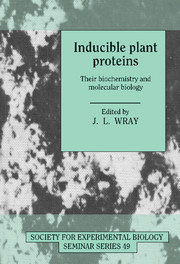Book contents
- Frontmatter
- Contents
- List of Contributors
- Preface
- Metal-binding proteins and metal-regulated gene expression in higher plants
- Phosphate starvation inducible enzymes and proteins in higher plants
- Nitrate reduction in higher plants: molecular approaches to function and regulation
- Inducibility of the glutamine synthetase gene family in Phaseolus vulgaris L.
- Expression and manipulation of genes involved in phenylpropanoid biosynthesis
- Biochemistry and molecular biology of CAM
- ABA- and GA-responsive gene expression
- Regulation of gene expression, ethylene synthesis and ripening in transgenic tomatoes
- Induction of nodulin genes and root nodule symbiosis
- Systemic acquired resistance: an inducible defence mechanism in plants
- Biochemistry and molecular biology of the anaerobic response
- The heat shock response in transgenic plants: the use of chimaeric heat shock genes
- Biochemistry and molecular biology of cold-inducible enzymes and proteins in higher plants
- GBF-1, GBF-2 and GBF-3: three Arabidopsis b-Zip proteins that interact with the light-regulated rbcS-1A promoter
- Index
Metal-binding proteins and metal-regulated gene expression in higher plants
Published online by Cambridge University Press: 06 July 2010
- Frontmatter
- Contents
- List of Contributors
- Preface
- Metal-binding proteins and metal-regulated gene expression in higher plants
- Phosphate starvation inducible enzymes and proteins in higher plants
- Nitrate reduction in higher plants: molecular approaches to function and regulation
- Inducibility of the glutamine synthetase gene family in Phaseolus vulgaris L.
- Expression and manipulation of genes involved in phenylpropanoid biosynthesis
- Biochemistry and molecular biology of CAM
- ABA- and GA-responsive gene expression
- Regulation of gene expression, ethylene synthesis and ripening in transgenic tomatoes
- Induction of nodulin genes and root nodule symbiosis
- Systemic acquired resistance: an inducible defence mechanism in plants
- Biochemistry and molecular biology of the anaerobic response
- The heat shock response in transgenic plants: the use of chimaeric heat shock genes
- Biochemistry and molecular biology of cold-inducible enzymes and proteins in higher plants
- GBF-1, GBF-2 and GBF-3: three Arabidopsis b-Zip proteins that interact with the light-regulated rbcS-1A promoter
- Index
Summary
Introduction
The growth of plants in nature depends on their ability to respond to their environment. For the metabolism of metals, plants require a balance between the uptake of sufficient essential metal ions to maintain growth and development and the ability to protect sensitive cellular activity from excessive concentrations of essential and non-essential metals. Although phytotoxic amounts of metal occur more frequently from industrial and agricultural pollution than in soils under natural conditions, nevertheless, survival mechanisms are required to detect not only external/internal concentrations of metals, but also essential from non-essential metal ions. Plants thus have the ability to ‘sense’ metal ions since it is central to normal metal metabolism, protection from metal toxicity, and adaptation to metal tolerance. Such recognition can be envisaged to occur by a number of physiological processes, but at the molecular level it is likely to be the binding of metal ions to a protein, which directly or indirectly changes the pattern of cellular activity, usually by changing gene expression. Evidence is now emerging that this molecular recognition is ‘programmed’: evolution has fashioned proteins either to have rigid binding sites which accept some ions while rejecting others, or to have flexible binding sites in which the stereochemistry of the ion determines the final shape of the protein. In either case, evolution has given the organism the capability to distinguish metals and partition them in different ways.
- Type
- Chapter
- Information
- Inducible Plant ProteinsTheir Biochemistry and Molecular Biology, pp. 1 - 24Publisher: Cambridge University PressPrint publication year: 1992
- 5
- Cited by



